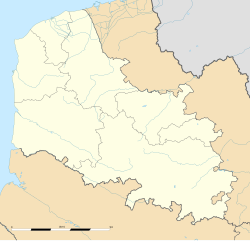Vitry-en-Artois airfield
| Aerodrome de Vitry-en-Artois | ||
|---|---|---|
|
|
||
| Characteristics | ||
| ICAO code | LFQS | |
| Coordinates | ||
| Height above MSL | 53 m (174 ft ) | |
| Transport links | ||
| Distance from the city center | 2 km northeast of Vitry-en-Artois | |
| Street |
D 950 , |
|
| Basic data | ||
| operator | Syndicat intercommunal à vocation unique (SIVU) de l'aérodrome de Vitry-en-Artois | |
| Runways | ||
| 04/22 | 900 m × 100 m grass | |
| 12/30 | 900 m × 100 m grass | |
The Aérodrome de Vitry-en-Artois is a airfield of general aviation . It lies in the region of Hauts-de-France in the department of Pas-de-Calais in the field of Vitry-en-Artois about two kilometers northeast of the town. The airfield was used as a military airfield during the Second World War .
history
The airfield already existed before the beginning of the First World War in connection with that of the Breguet company at the nearby Douai-Brayelle airfield . During the First World War, it was a base for the German air force , and well-known flying aces such as Immelmann and Richthofen were stationed here.
During the western campaign of the German Wehrmacht , Vitry was used by German Bf 109E fighters in World War II . From the end of May and the first third of June 1940, the I. Group of Jagdgeschwader 54 (I./JG 54) and II. Group of Jagdgeschwader 51 (II./JG 51) were located here.
During the ensuing Battle of Britain the airfield became a bomber base. The I. Group of Kampfgeschwader 53 (I./KG53) lay here with their He111 from mid-June 1940 until shortly before the start of the attack on the Soviet Union in mid-June 1941.
The airfield was expanded by the German occupation forces and after a year and a half of relative calm, Vitry became a fighter base again in early January 1943. Initially, the II. Group of Jagdgeschwader 26 (II./JG 26), equipped with Fw 190A and Bf 109G, was stationed here until the end of July 1943 . It was followed at the beginning of August by the II. Group of Jagdgeschwader 2 (II./JG 2). She only flew the Fw 190A and stayed here until the end of September 1943.
In the second half of January 1944, Vitry became the base of the V. Group of Kampfgeschwader 2 (V./KG 2), which was equipped with the Me 410A / U , for two weeks . The last Luftwaffe formation lying here was the first group of JG 26 (I./JG 26) on Fw 190 in the last third of August 1944.
After the area was liberated by the Allied First Canadian Army at the end of August 1944, the United States Army made makeshift repairs through Allied bombing and demolitions by the retreating Wehrmacht . In early September was Airfield B.50 , its allied code name, for two weeks location of the 184 Squadron of the British Royal Air Force , with Typhoon IB - fighter-bombers equipped. Between mid-September and mid-October, Vitry was then the base of operations for the 358th Fighter Group of the Ninth Air Force of the United States Army Air Forces (USAAF) equipped with P-47 fighter bombers .
After that, the place became the base of the 137th wing of the RAF, a bomber squadron, whose four squadrons were initially equipped with Mitchell II ( 226th Squadron ) and Boston III / IV ( 88th and 107th Squadron ). Vitry was the first airfield of the Free French Air Force in liberated France. Their bomber group "Lorraine" was stationed here as part of the 137th Squadron as 342nd Squadron . The three squadrons from mid-November 1944, the 107th squadron had been relocated at that time, were here until April 1945.
During Operation Varsity in March 1945, he also served Allied transport aircraft and after the war ended, USAAF A-26 bombers were still lying here between the end of May and the end of July 1945 . They belonged to the 391st Bombardment Group . The airfield was returned to France in December 1945.
The French military had no use for the old airfield, whose unpaved areas were used for agriculture. Later the paved runways were removed and the former airfield area could be used completely for agriculture.
Today's airfield was built south of the former military airfield, but remnants of the earlier runways and some taxiways are still visible today.
Web links
- Aeronautical map for Vitry-en-Artois airfield on SkyVector.com
